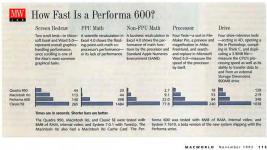I've been thinking about this today.
Firstly, I apologize if I missed a joke.
Secondly, I think it's worth considering the issue of "whether it's worth fixing a {any road apple}" and "whether or not {model} should have existed" separately, because they really are two different things.
In the modern environment where it can be harder and harder to track down working vintage Macs, I think it's worth repairing every Mac, even ones that'll be slow. In addition, yeah, the IIvi/vx/P600 will be disappointing compared to {better machine}, but they should be reasonably performant compared to older and smaller machines. For somebody who didn't have a specific need for, say, an LCPDS Apple IIe card, I see no reason why a IIvi/vx/P600 wouldn't work for them. Plus, with metal frames and as far as I know relatively few problems where there is plastics, these machines should ship well.
Ultimately, to not keep and restore and for a couple people not to be using these machines (and other "road apples") would essentially be revisionist. If we're at all in it for appreciating the platform, then it's worth appreciating the whole platform. (This applies even to those of us who have specific interest in other machines, for whatever reason.) But, for lack of a better way to put it, puttering around in Finder, basic productivity software, simple games and things like HyperCard is what most people do on most vintage Macs, so the fact that the IIvi/vx/P600 doesn't live up to the performance of some other models, or the needs of 1992's DTP/Photoshop power users isn't strictly relevant, here. Heck, just about everything I've been doing on my 840 over the past few years would work fine on a P600, just, I'd lose out on my 1152x870 display unless I put in a card. (to be perfectly honest: that's no big deal, I was also doing all that stuff at 640x400 on a PB180.)
The other issue, of whether or not Apple should have built it (or handled its release, pricing, positioning, and discontinuance) any different is, well, a different issue. My main comment there is that, arguably, Apple flubbed the entire Mac product line from 1987 to 1997, so arguing for or against specific models becomes kind of moot.
My recollection (Macworld, November 1992, P.112) is that the Performa 600 retailed in a bundle for around $2500, including 5m/160m a CD drive, and 1MB of video ram, or $2000 for 4/160, no CD, and 512k VRAM, whereas the IIci was (still) on sale for around $4000 for a 5/80 config. MacWorld said it was "bargain pricing", although they admitted that overall the P600 should come in around 50-80% the overall performance of the IIci. (Again, Quadras also already existed, so we're definitely talking about a machine designed to be sold alongside washing machines and vacuum cleaners in a department retail setting.) As a bundle note, it looks like the Performas 400 and 600 did not include monitors. The new Performa display was $450, compared to the $999 of the 13-inch high resolution display, so figure about $3000 out the door for a Performa 600 and close to $6000 out the door for a IIci with its "matching" display, a keyboard, and application software, which was varyingly bundled with the initial group of Performas. (the article isn't clear if there was a single bundle or if different retailers changed the bundle, as with all subsequent Performas.)
It's not hard to see why Apple did what they did with the Performas, and in terms of building systems that were a reasonable value and provided a reasonable amount of choice and variety, the 200/400/600 are what I'd call a reasonably good product stack. These were systems designed to try to win people over from cheap 286es and super-budget 386es - not high performance graphics or office computers.
All that said: the P600 does lack cache functionality, but IIci CPU upgrades should work in it, so it's also got that going for it, relative to, again, lower end machines.
Overall, I actually question why the IIci was on sale when the clear flagships at the time were Quadras 700 and 900.
To re-address the editorializing on LEM's profile of the P600, I don't think anybody who already owned a IIci in 1992 was looking at all seriously at the P600, unless perhaps they had a need for another computer, in addition to the one they already had. (For an employee or family member to use, or to use as a home computer where their IIci was in an office.) MacWorld is very straight-up about the P600's performance, but it could've looked attractive as it would've been faster than the P200/400 (CII/LCII) and used common expansion and upgrade boards with other Mac II family machines, making the P600 a potential candidate to slot in, say, where an original Mac II had been. (MacWorld doesn't address that directly, however.)
So, there's my bit... again. Sorry for duplicating much of that stuff, in an effort to hopefully provide it in a more structurally sound way.

